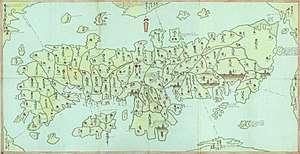Tsuwano Domain
The Tsuwano Domain (津和野藩, Tsuwano-han) was a Japanese domain of the Edo period. It was associated with Iwami Province in modern-day Shimane Prefecture.[1]
The remains of Tsuwano Castle
In the han system, Tsuwano was a political and economic abstraction based on periodic cadastral surveys and projected agricultural yields.[2] In other words, the domain was defined in terms of kokudaka, not land area.[3] This was different from the feudalism of the West.
History
The Meiji-era author Mori Ōgai was the son of a Tsuwano retainer.
List of daimyōs
The hereditary daimyōs were head of the clan and head of the domain.
- Kamei clan, 1617–1868 (tozama; 43,000 koku)[4]
- Kamei Masanori[4]
- Kamei Koremasa
- Kamei Korechika
- Kamei Koremitsu
- Kamei Korenobu
- Kamei Koretane
- Kamei Norisada
- Kamei Norikata
- Kamei Korenao
- Kamei Korekata
- Kamei Koremi
gollark: My laptop is just a large heavy cuboid of plastic.
gollark: My laptop has a USB-C port which can do video and it also has USB-A and such.
gollark: You can have USB-C *and* other things.
gollark: It's a big chip on a cutting-edge process with HBM on it.
gollark: To be fair, the M1 is probably ridiculously costly to make too.
See also
- List of Han
- Abolition of the han system
References

- "Iwami Province" at JapaneseCastleExplorer.com; retrieved 2013-4-23.
- Mass, Jeffrey P. and William B. Hauser. (1987). The Bakufu in Japanese History, p. 150.
- Elison, George and Bardwell L. Smith (1987). Warlords, Artists, & Commoners: Japan in the Sixteenth Century, p. 18.
- Papinot, Jacques Edmond Joseph. (1906). Dictionnaire d'histoire et de géographie du Japon; Papinot, (2003). "Kamei" at Nobiliare du Japon, p. 19 [PDF 23 of 80]; retrieved 2013-4-25.
External links
- "Tsuwano" at Edo 300 (in Japanese)
This article is issued from Wikipedia. The text is licensed under Creative Commons - Attribution - Sharealike. Additional terms may apply for the media files.